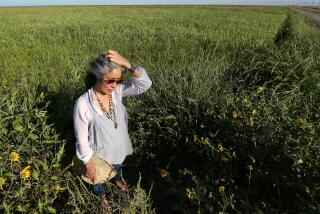Kenter Canyon Farms reaps harvest of locally grown wheat
California farmers raise vast quantities of wheat, but this most basic of foods has remained an industrial commodity, absent from farmers markets. That may be changing, however, since a passionate bread baker, Andrea Crawford of Kenter Canyon Farms, launched her “farm to toaster” program this week, selling locally grown heritage wheatberries and freshly milled flour, and artisanal bread baked from it, at the Santa Monica Wednesday and Hollywood markets. Some of the breads sampled so far are superb, and Kenter’s venture heralds a coming wave of local grain.
“I’ve been a serious home baker for years but couldn’t find any commercial flour that I liked, so I started milling my own,” says Crawford. “Then it occurred to me, ‘I’m a farmer. I can grow my own grain.’ ”
She and her husband, Robert Dedlow, who have prospered farming greens and herbs, took the gamble. With the help of food writer Sonoko Sakai of Common Grains, they obtained several tons of seeds of Sonora, Glenn and Red Fife wheat, and sowed them in November on 50 acres in Hollister, a historic wheat-growing town east of Watsonville, Calif.
In July, a custom harvester reaped 45 tons. Crawford bought a Meadows 20-inch Ultimate grain mill that cost as much as a new car, she says. After months of tests, Kenneth Curran, an alumnus of the San Francisco Baking Institute, baked up a storm early last Wednesday at a wholesale bakery in downtown Los Angeles. Hours later, Crawford and Dedlow sold three styles of bread: a baguette, a country round and a sandwich loaf, each identified by wheat variety, for $4 to $8 at the Santa Monica market.
The bread (displayed next to the Maggie’s Farm stand run by Crawford’s son, Nathan Peitso) attracted an eager, curious crowd, and it had virtually sold out by the end of the market. Among the favorites so far are the Red Fife whole wheat sandwich loaf, delightfully sour and full-flavored, and the Sonora transitional loaf, with 15% of the bran removed, which is sweet, fragrant and nutty. The Sonora baguette is crusty on the outside, chewy, slightly sour and flavorful. Crawford herself adores dark northern European breads with a dense, chewy texture, made from 100% whole grain.
It’s a big advantage that the bread is baked from freshly milled flour, says Joseph Shuldiner, director of the Institute of Domestic Technology, a home economics school in Altadena. Flour may look indestructible, but “as soon as you open up the kernel of the whole wheat, there’s oil in it, and when it is exposed to oxygen, it goes rancid,” he adds.
In the 19th century, wheat was one of the most important crops grown in California, and by 1889, the state ranked second in the nation for wheat, producing more than 40 million bushels on 2.75 million acres. After 1900, plantings declined as California farmers found that growing specialty crops such as peaches or lettuce was more profitable; today, the vast majority of the nation’s 50 million acres of wheat are grown on huge farms in the Midwest. In California, there are still more than 700,000 acres, mostly in the Central Valley; about a tenth of the total is in the Imperial Valley, near the Mexican border.
Last month, Kenter planted 25 acres of organic land in Imperial County with farro, an ancient wheat, which should be ready for harvest next spring. Dedlow and Crawford currently are marketing their wheat under the Kenter Canyon banner, but their labels also bear the name Roan Mills (from Robert plus Andrea), which will become the primary name for the venture once some paperwork issues have been settled. They have launched a website under that name with photos, recipes and news. By next summer, they plan to have opened a wholesale bakery and small cafe, a project managed by Peter Scherer, formerly of Storefront Deli in Los Feliz. It will be in a bakery building constructed in 1919 in Fillmore, near Kenter’s Ventura County greens farms.
Soon we may be seeing more locally grown grain at specialty and farmers markets. Three partners who call their project Restoration Grains have planted 6 acres in Upper Ojai. A small-batch flour mill, Grist & Toll, will open soon in Pasadena. This fall, Nate Siemens of Fat Uncle Farms is planning to sow more than 100 acres of heirloom grains in Kern and Santa Barbara counties, and Alex Weiser of Weiser Family Farms will put in an experimental wheat planting in Tehachapi.
Peruvian apple quince
Weiser also grows the rare Peruvian apple quince, which is a true quince botanically, but it’s edible fresh, with pleasure, like an apple, and he will sell it for the first time next Wednesday at the Santa Monica farmers market. Quinces are pome fruits, closely related to apples, but commercial varieties are so hard, tart and astringent that they are more like furniture than food when raw; when baked and sweetened, the flesh develops a pink color and an exquisite aroma. Near the quince’s area of origin in western Asia and southeastern Europe, as well as in South America, however, there are a few more tender, juicy, nonastrigent varieties that are delicious eaten fresh.
The Peruvian apple quince comes from the Majes Valley of southern Peru, near Arequipa, where it is known as membrillo manzano (apple quince) and it is common in home gardens. Brought to California a few decades ago by Noel Ugarteche, it was promoted here by his neighbor in Simi Valley and fellow Peruvian American, Edgar Valdivia, a prominent member of California Rare Fruit Growers.
About 15 years ago, acting on a tip from me, CRFG fruit guru C. Todd Kennedy sent budwood of this tree to the U.S. Department of Agriculture’s fruit collection in Corvallis, Ore. There, much to my surprise, quince curator Joseph Postman called the variety Karp’s Sweet quince. Raintree Nursery in Washington state started offering the tree, and five years ago, Weiser put in a small planting in Tehachapi.
The trees are still young, so only modest quantities of fruit will be available next Wednesday and possibly the following week, but it will be interesting to see whether the Peruvian apple quince attracts customers. Many Latin Americans like to eat quince, often flavored with salt or chile powder, even when it is relatively woody, so a more palatable form might prove even more popular.
More to Read
Eat your way across L.A.
Get our weekly Tasting Notes newsletter for reviews, news and more.
You may occasionally receive promotional content from the Los Angeles Times.






